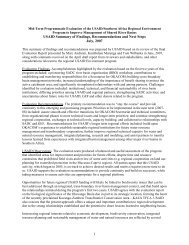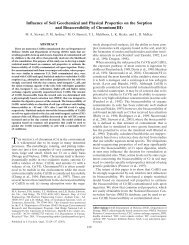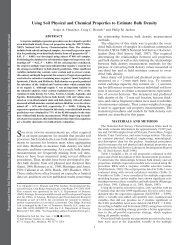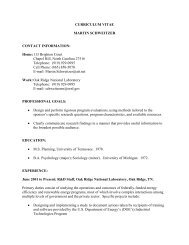Reptile and Amphibian Abundance and Distribution Survey - Oak ...
Reptile and Amphibian Abundance and Distribution Survey - Oak ...
Reptile and Amphibian Abundance and Distribution Survey - Oak ...
- No tags were found...
Create successful ePaper yourself
Turn your PDF publications into a flip-book with our unique Google optimized e-Paper software.
A.2.2SnakesEastern Worm Snake—Carphophis amoenus amoenusEastern worm snakes occur through most of the southeast.Their habitat includes hardwood forests in high elevations,where they can be found under rocks, logs, <strong>and</strong> debris. Whilethey have been found in forested wetl<strong>and</strong>s, they are mostprominent in dry upl<strong>and</strong>s.Eastern worm snakes spend most of their timeunderground or in burrows. They remain inactive on hot days,<strong>and</strong> their activity peaks during the fall. The snakes can remaindormant for up to 2 weeks at a time. Males travel from theirStudy photohome ranges much more than females. Their diet containsearthworms, invertebrates, <strong>and</strong> some insect larvae. The snakes are very secretive, <strong>and</strong> their habits are notwell documented.Breeding takes place in spring <strong>and</strong> fall, <strong>and</strong> females lay up to a dozen eggs in June <strong>and</strong> July. Theyoung reach sexual maturity after 3 years.Because of their secretive nature, little is known about their lifespan <strong>and</strong> status. The populations arebelieved to be dense where their habitats are favorable.Northern Ringneck Snake—Diadophis punctatus edwardsiiThe northern ringneck snake occurs in most of the central<strong>and</strong> eastern parts of the United States, <strong>and</strong> its range continuesalong the western coast. Populations are missing in thenorthwestern United States but are found almost everywhereelse.Northern ringneck snakes rely on a huge variety of habitats,evident by their large range. They shelter under rocks, logs, <strong>and</strong>leaf cover. The snakes prefer moist conditions but are known tosurvive without permanent water sources.Ringneck snakes are primarily nocturnal; however,Photo by Scott Dykes ©individuals can be spotted at all times of day. The species rarelybites in defense against predators, <strong>and</strong> instead plays dead or flips over to reveal its brightly coloredstomach <strong>and</strong> distract its predators. When attacked, the species gives off a strong-smelling musk. Thespecies does not harm humans.The ringneck snake breeds during spring <strong>and</strong> fall, <strong>and</strong> eggs are laid in June <strong>and</strong> July. Eggs can be laidin communal nests but only where colonies of the snakes are present. The females lay 3 to 10 eggs, <strong>and</strong>the eggs hatch in 7 to 8 weeks.Ringneck snakes are common in their range. The species is believed to live up to 10 years in the wild.A-14
















